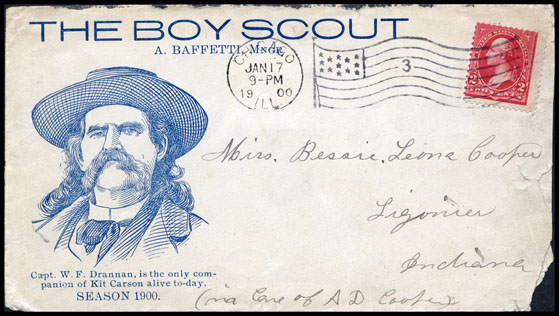
The Boy Scout
The First Boy Scout & the First Boy Scout Cover
01/17/1900
Chicago, IL
Printed
Blue
Drannan & Baffetti
This is the earliest known use of the term "Boy Scout" on any philatelic piece.
To put the significance of this cover in its proper perspective, we need to take a quick look at some of the
actual history of scouting’s beginnings and the early usage of the term “boy scout”. (For a proper look, see or
google Colin Walker’s “What’s in a name”, boyscoutstuff.com, Scouting Milestones, or one of his books. He is
the preeminent Scout historian). The term “Boy Scout” appeared in October, 1899 in a British publication
referencing fictional characters. These “Boy Scout” adventure magazines, from Aldine Publishing, were
popular for several years. In 1902 Ernest Thompson Seton started his scouting organization in the US and in
1905 Daniel Carter Beard started his; albeit under different names. By 1906 Seton had met with Baden-
Powell and had significant influence on his developing program in what was to become the first Boy Scout
organization. The 1911 BSA Handbook, of which reprints are readily available, shows Seton as the Chief
Scout, Beard as one of three National Commissioners, and both on the 16 man Executive Board as well as
the 190 man National Council. Chapter 1 explains two types of scouts; “war” scouts and “frontier” scouts,
and goes on to introduce the “Boy Scouts”. The story where Boyce is helped by a Boy Scout in a London
fog, and then simply founded the BSA 81 days later had yet to be written.
This cover is about a real [frontier] scout who referred to himself as “The Boy Scout”, in print, prior to the
Aldine publications and just prior to the Siege of Mafeking.
William F. Drannan (1832-1913) at age 15, in 1847 set out on his own and joined Kit Carson as an indian
scout. He later wrote two books about his life: THIRTY-ONE YEARS ON THE PLAINS AND IN THE
MOUNTAINS; or, THE LAST VOICE FROM THE PLAINS. An Authentic Record of a Life Time of Hunting,
Trapping, Scouting and Indian Fighting in the Far West, Rhodes & McClure, Chicago, IL, 1899.
The preface is signed and dated August 1, 1899. In the book he refers to himself several times as the
“boy scout”. Ex: “I told her my name was William F. Drannan, but I was better known on the plains as the
Boy Scout”……. “You are the boy scout that was with Capt. Mills last summer and you rode in my wagon”.
The book was evidently successful as there were several editions by several publishers from 1899 thru 1910.
Also in 1910, he published a sequel: CAPT. WILLIAM F DRANNAN, CHIEF OF SCOUTS, Rhodes & McClure, Chicago, IL.
Drannan is not now part of the Boy Scouts of America legend but early on he was known. In the seminal
book Boy Scout’s Hike Book, Edward Cave, 1913, Cave wrote: “The Eyes of Old-Time Scouts: The only
old-time Scouts whose eyes I have noticed particularly have been Captain Wm F. Drannan who was Chief of
Scouts under General Crook, and……….Captain Drannan had the intense eyes of an eagle or a hawk.”
Also, in the Boys’ Life “Special Western Number” August, 1928, Dick Rutledge (Indian Scout), at the age
of 83, contributed an article “Scoutin’ with Kit Carson” in which he wrote of the time he joined Carson in
1866 and was introduced to Drannan: "Drannan was only slightly older than we, but he was a veteran in the
Scouting business having been with Carson since his boyhood."
In the light of this cover, the 2010 US generic “youth scouting movement” stamp can be visualized as an
allegorical and anachronistic rendering of a frontier scout; those intrepid souls, who from about 1830 to
1880, were mountain men, led wagon trains, scouted trails, were indian scouts for the army, and scouted
for and, if necessary, fought with hostile Indians. Just like Drannan did.